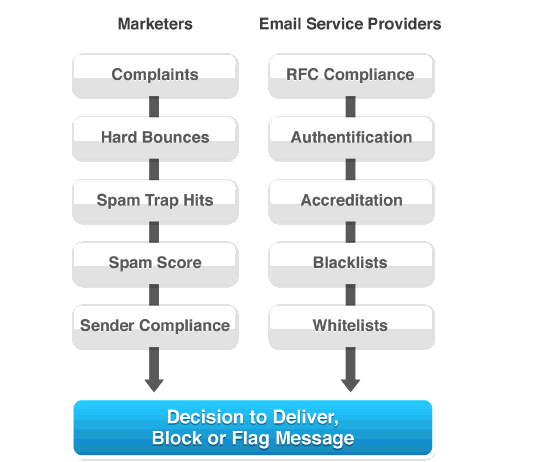As a sender, you’ll gradually acquire a reputation as you send messages over time. The combination of content, how often recipients flag your emails as junk, spam traps, and your bounce rate all contribute to this reputation.
A good reputation has a great impact on the effectiveness of your marketing efforts. A bad reputation does the exact opposite and may prevent your emails from reaching your audience at all.
Cultivate and nurture your reputation by:
- Practicing good list hygiene
- Sending valuable content
- Keeping your audience engaged
Several factors impact the reputation of a sender:
Managed by Senders
Complaints
This is the rate of formal complaints, or the number of recipients marking messages as spam. Avoiding complaints relies on sending quality content to subscribers who have opted-in to receive your emails.
Hard Bounces
The hard bounces rate is the percentage of emails you send that are sent to expired or inactive addresses. This can be managed by maintaining an up-to-date subscriber list and ensuring it’s easy for people to unsubscribe or modify their information when their contact details or circumstances change.
Spam Trap Hits
Spam traps are email addresses intentionally designed to identify spammers that are harvesting addresses off the Internet and/or senders who have poor list hygiene or opt-in practices. To avoid this, make sure your opt-in process is a double opt-in list that requires people to confirm their email address before they are added to your list and send on a regular basis.
Spam Score
This is the element of email deliverability over which senders have the most control and yet it’s often the most neglected. What matters more than words that might flag spam filters – is bad content that encourages the recipient to delete your message, opt out of future messages, block you entirely, or worst of all complain to their ISP by flagging your message as spam.
Sender Compliance
This is measured by how well you adhere to the above requirements. Each mark against you will affect how your future email is handled. How each ISP deals with this can be different – some have higher thresholds than others so you need to stay compliant in all areas in order to keep out of trouble.
Managed By Your Email Service Provider
Technical Compliance
Better known as RFC (Request for Comments), which is a set of standards for the internet as decided on by the IETF (Internet Engineering Task Force). At a high level, RFC compliance is solely the responsibility of your Email Service Provider and without it most (if not all) of your email will never make it past the initial connection
Authentication
Because spammers often masquerade as legitimate senders (claiming that their emails are coming from a real company) receivers will often look to authentication as a way to see if the sender is really who they say they are. This is especially important when using an email service provider as they may (or may not) be allowed to send on your domain’s behalf. There are four main protocols in use today (SPF/Sender ID, Domain Keys and DKIM), but because none of these protocols are dominant any reputable email marketing platform will make all available to their clients to help maximize delivery.
Accreditation
Some senders get approval from anti-spam organizations and 3rd party Reputation Providers for certifications such as Goodmail, Return Path’s SenderScore Certified and the Habaes Safelist. This means they are pre-approved or ‘whitelisted’ senders and the ISPs that use these Accreditation services will give preferential treatment to these senders by allowing more email to the inbox and quite often it will by-pass more heuristic forms of spam filtering such as content filtering, throttling or disabling links/images by default.
Blacklists
A blacklist is a list used by receiving networks to judge a given IP and/or sending domain’s reputation. These lists are run by anti-spam groups and most blacklistings are the result of sending Unsolicited Bulk Email (UBE) to addresses that never asked for it. There are many different blacklist providers in existence and some carry more weight in the community than others so it’s very important you keep your lists clean or you will run into trouble.
Whitelists
Similar to accreditation where reputation is acquired by the means of an outside source, many ISPs maintain their own internal whitelists as well. They are made up of IP addresses or domains that generate very few complaints, bounces and have a high level of engagement with their users. This can also be done by a recipient adding your From address to their Contact of ‘Safe Sender’ list or going into their Junk folder and telling the ISP your email is NOT spam.
